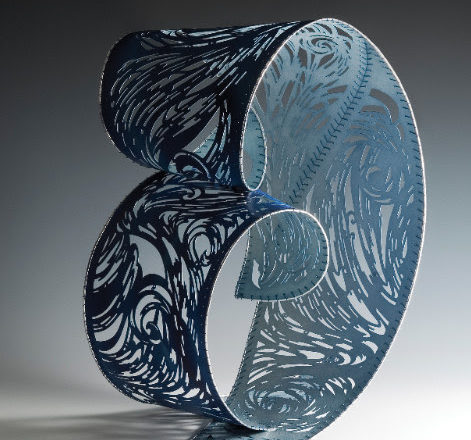Natural composites can be made by combining the tensile strength of leaf phloem fibres with a bonding matrix from plant-derived tannins.
An example with properties comparable to sheet plastic (strong, flexible, water-resistant) is made with Mulberry leaf fibres bonded with Persimmon based glue, for Katagami, the traditional Japanese craft of making paper stencils for dyeing textiles.
Uses
- Kategami stencils
Potential Uses
Although we are not aware of contemporary usage of this material, we wonder whether this or similarly created natural composites could replace materials such as plastic sheet in any contemporary contexts:
- Bags? (particularly that need to be water-resistant)
- Laptop / Pad / Phone sleeve?
- Document folders?
- Book covers?
- Shoes?
Additionally, perhaps the leaf fibres/washi paper could be used as a bulk material, as discussed in this article
Processes
Washi paper (fibres)
The paper is commonly made using fibers from the bark of the gampi tree, the mitsumata shrub (Edgeworthia chrysantha), or the paper mulberry, but can also be made using bamboo, hemp, rice, and wheat. For example, a DIY process for obtaining fibres from Mulberry bark:
- Harvest branches ~3cm diameter, cut into lengths that will fit into steaming pot.
- Steam for 1 to 2 hours, causing the bark to shrink so it is easy to strip from the Xylem. Peel off in strips then scrape off the outer bark as much as possible using a dull knife. The Inner Bark that is composed of the Phloem fibers.
- If the branches were dried, soak the fibers in water for 12 hours to help remove chlorophyll.
- Boil fibres for 1-2 hours in baking soda solution to separate the fibers by dissolving the calcium pectates within the middle lamella.
- The fibers should pull apart in your hands. Rinse thoroughly.
- Pound into a pulp e.g. with rolling-pin for 1-20 minutes.
- This can then be used to make paper (many descriptions online; basically distribute fibers in water and use a mesh rectangle to lift out a paper-thin layer, then dry.)
Kakishibu (Persimmon Tannin Juice glue):
The glue (composite matrix) is traditionally made by fermentation of the tannin-rich juice of astringent (not sweet) varieties of persimmon; such as (in Japan) Ten’nou, Tsurunoko, and Hourenbou:
- Harvest unripe fruit (containing abundant tannin) in middle to late August.
- Juice by pressing, including the peel.
- Filter.
- Ferment for ‘a few years’ to make persimmon tannin. The colour darkens as it matures. It must be stored at an appropriate temperature.
‘Katagami’ composite:
The stencil material is made by bonding three sheets of thin washi paper together using kakishibu paste.
